Mendoza,Argentina 作者: 来源: 发布时间:2021-06-02
一、人口,面积,所属地区
Mendoza, officially the City of Mendoza (Spanish: Ciudad de Mendoza) is the capital of the province of Mendoza in Argentina.
Population: 115 041 (2010 census)
Area: 57 km²
Location: It is located in the northern-central part of the province, in a region of foothills and high plains, on the eastern side of the Andes.
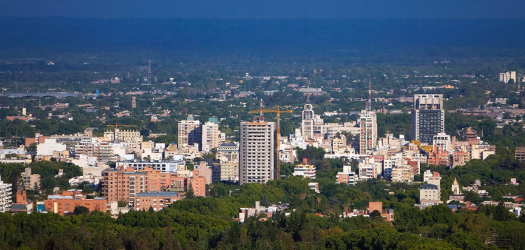
二、自然地理
Transportation
The public transport system includes buses, the Mendoza trolleybus system, and taxis. The trolleybuses are more comfortable than the diesel buses, but are slower, not as numerous nor is the system as extensive. In 2008, TransLink of Vancouver, British Columbia, Canada, sold most of its old trolleybus fleet to Mendoza.
A heritage railway, El Tren del Vino (The Wine Train) is being planned which will also provide local transportation; it will run through wine-producing districts of Mendoza.
Metrotranvía: A new 12.6-kilometre (7.8 mi) light rail line, the Metrotranvía Mendoza, opened for regular service in October 2012. and serves five areas of the Greater Mendoza conurbation. The line runs from Estación Central (at the site of the former intercity passenger train station, near the city centre) south to Maipú. The bright red railcars, Siemens-Duewag U2s, were purchased from the San Diego Metropolitan Transit System (MTS) of San Diego, California, USA in 2010. They were built in 1980.
Transandine Railway: Mendoza's development was helped partly due to its position at the start of the Transandine Railway linking it to Santa Rosa de Los Andes in Chile. The only railway operable between Argentina and Chile, after many years of inactivity, it remains currently abandoned.
The Transandine Railway is a 1,000 mm (3 ft 3 3⁄8 in) metre gauge line, with sections of Abt rack, whilst the railways it links with are both 1,676 mm (5 ft 6 in) broad gauge. A journey from Buenos Aires to Chile involved two breaks-of-gauge, and therefore two changes of train, one at Mendoza, and the other at Santa Rosa de Los Andes.
Urban structure and environment
The city of Mendoza is divided into districts called sections originating from the primitive limits of police jurisdiction.
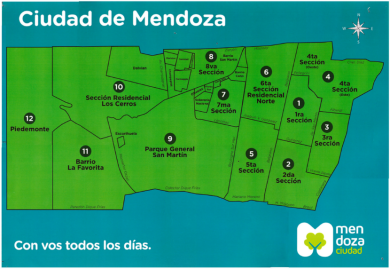
12 sections of the city of Mendoza
Although it is situated in an extremely dry desert region, Mendoza has an extensive artificial irrigation system, which allows for greenery throughout the city as well as the growth of grapes used to make its wines. Most streets have irrigation channels on either side, with bridges for pedestrian and vehicular traffic. These are periodically flooded with water diverted from the river. The 80,000 trees and the wide avenues give the city a beautiful ambience.
三、经济发展和规模
The province of Mendoza ranks 4º as regards GDP in Argentina with USD 9,246 per capita and an annual growth rate of 2% (2004-2016), making it the fifth largest economy of Argentina. Its 2013 output was estimated at US$18.8 billion, or, US$10,758 per capita below the national average, at a level similar to Turkey and above Mexico. Agriculture, to be sure (though 7% of the total economy), has long accounted for much of Mendoza's foreign exchange earnings (followed closely by tourism, mainly from Chile). Besides wine, other important crops (mainly for the Argentine market) are apples, pears, tomatoes, onions, plums, olives, cherries, peaches and quince. Apiculture, with 30,000 beehives, is another growing activity favoured by Mendoza's dry weather.
As for the city of Mendoza, it is a main industrial hub, a fundamental strategic point of Mercosur relations. Its economic activity is linked to commerce, the service industry and mainly the tourist activity around the wine industry, which is why, together with other cities in the world, it is called ‘International Wine Capital’.
四、产业特点/重点项目
Two of the main industries of the Mendoza area are olive oil production and Argentine wine. The region around Greater Mendoza is the largest wine-producing area in South America. As such, Mendoza is one of the nine Great Wine Capitals.
Wine industry
Mendoza’s wine region is over 350,000 acres (144,000 hectares) of planted vineyards, and produces nearly two-thirds of the country’s wine. There are more than 1,500 wineries spread out through the three main wine regions - Lujan de Cuyo, Valle de Uco and Maipu.
Lujan de Cuyo
With vineyards planted in sandy soil at an altitude of 2,640–3,630 feet, Lujan de Cuyo is known as the land of Malbec. It is part of Mendoza River's high region. Most of the vines here are planted with red wines, but Malbec is not the only grape thriving here. Cabernet Sauvignon, Chardonnay, and Torrontes also thrive well.
About 40 minutes south of Mendoza city, this region is considered the place where Argentina's wine movement began - pushing the country from the common table to international production. Luján de Cuyo was the first region to institute the AOC (Appellation d'Origine Controlée) for Malbec in 1993. This has caused continual increase in the quality and quantity of the wines, and increased global recognition.
Uco Valley
Approximately 75 minutes south of the city of Mendoza, the Uco Valley (Valle de Uco) is Mendoza's newest wine region, and the one getting the most attention internationally right now. It is known especially for Malbec, Merlot, Pinot Noir, Semillon and Torrontes production. The breathtaking natural scenery makes it one of the most picturesque regions in Mendoza.
The Uco Valley has received much global acclaim in 2012, although it has been producing top quality wines for well over a decade. The area is known for its high altitude, with the Tupungato region having vineyards planted almost 4,000 feet above sea level. Uco Valley is in fact one of the world’s highest wine growing regions, with over 80,000 hectares planted between 3,000-3,900 feet.
In addition to producing award-winning Malbecs and blends, the area is also emerging as a source for premium quality white wine varietals such as Chardonnay, Sauvignon Blanc, and even Torrontes.
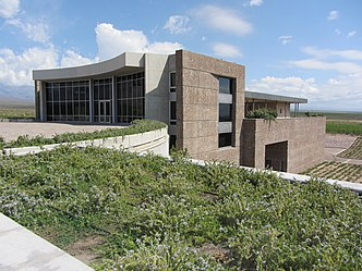
Diamandes Winery in Uco Valley
MAIPU
The region of Maipu, south and east of Mendoza city, has approximately 20 wineries.
五、风景名胜,景点
Parque San Martín
This huge park is nice for walking or biking around. There is also a zoo at the north-west corner of the park with animals in small cages. Behind the zoo begins a path up to Cerro de la Gloria where there is a large statue and nice view over the city and of the mountains - particularly pleasant at sunset.
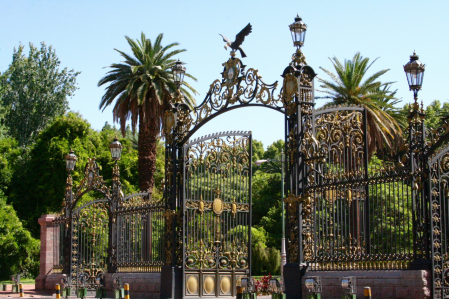
Plaza Independencia.
The central main square of the city is the best starting point to explore downtown Mendoza. It boasts some nice buildings around, restaurants and even some street shows. The Mendoza Museum of Modern Art is located under the plaza also (Ar$6, free on Wednesdays). The Plaza can also be visited at night, where you can see some nicely illuminated buildings and a beautiful big coat of arms of the city that is made of lights.
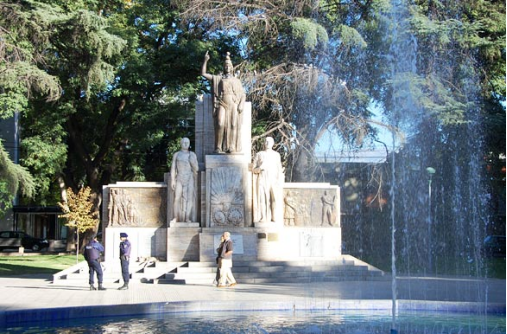
Plaza España.
Possibly the most beautiful square in the city, this square is an artistic expression of the special relationship that this city (and all others in Hispanic America) has with Spain. It is decorated in a splendid way with typical Andalusian and Spanish motifs all around the place. The central wall depicts some images and texts of the Spanish colonization and it is crowned by a gorgeous statue.
Central Park, El Parral & Vendimiadores (10 blocks north of Plaza Independencia). A modern city park, contrasting with the tradition of the better-known Parque San Martin. Not a Mendoza must see, but the park has some nice water fountains and a grassy hill - often amateur Mendocinans set up their easels here and paint away.
Casa de Fader
A historic house museum, is an 1890 mansion once home to artist Fernando Fader in nearby Mayor Drummond, 14 km south of Mendoza. The mansion is home to many of the artist's paintings.
Mendoza City Cemetery
Created in 1829, but inaugurated in 1846, the cemetery has become one of the main tourist points of the city, not only for the guided tours that the Municipality of the City of Mendoza carries out in it, but also for the funerary art that it possesses and for having the Remains of some recognized figures from Mendoza's history such as Juan Cornelio Moyano, José Néstor Lencinas, Carlos Washington Lencinas, Jacinto Álvarez, among others.
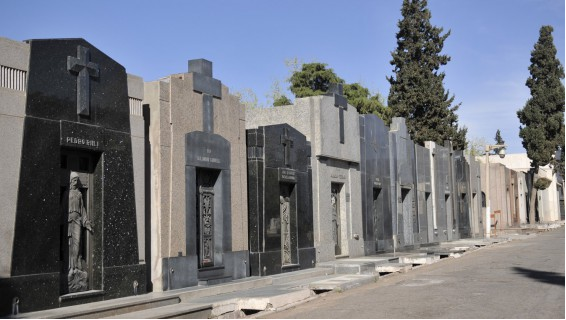
六、历史文化
On March 2, 1561, Pedro del Castillo founded the city and named it Ciudad de Mendoza del Nuevo Valle de La Rioja after the governor of Chile, Don García Hurtado de Mendoza. Before the 1560s the area was populated by tribes known as the Huarpes and Puelches. The Huarpes devised a system of irrigation that was later developed by the Spanish. This allowed for an increase in population that might not have otherwise occurred. The system is still evident today in the wide trenches (acequias), which run along all city streets, watering the approximately 100,000 trees that line every street in Mendoza.
It is estimated that fewer than 80 Spanish settlers lived in the area before 1600, but later prosperity increased due to the use of indigenous and slave labor, and the Jesuit presence in the region. When nearby rivers were tapped as a source of irrigation in 1788 agricultural production increased. The extra revenues generated from this, and the ensuing additional trade with Buenos Aires, no doubt led to the creation of the state of Cuyo in 1813 with José de San Martín as governor. It was from Mendoza that San Martín and other Argentinian and Chilean patriots organized the army with which they won the independence of Chile and Peru.
Mendoza suffered a severe earthquake in 1861 that killed at least 5,000 people. The city was rebuilt, incorporating innovative urban designs that would better tolerate such seismic activity. Mendoza was rebuilt with large squares and wider streets and sidewalks than any other city in Argentina. Avenue Bartolomé Mitre and additional small squares are examples of that design. Tourism, wine production, and more recently the exploitation of hard commodities such as oil and uranium ensure Mendoza's status as a key regional center.
Culture
Mendoza has several museums, including the Museo Cornelio Moyano, a natural history museum, and the Museo del Área Fundacional (Historical Regional Foundation Museum) on Pedro del Castillo Square. The Museo Nacional del Vino (National Wine Museum), focusing on the history of winemaking in the area, is 17 kilometres (11 miles) southeast of Mendoza in Maipú. The Casa de Fader, a historic house museum, is an 1890 mansion once home to artist Fernando Fader in nearby Mayor Drummond, 14 kilometres (9 miles) south of Mendoza. The mansion is home to many of the artist's paintings.
The Fiesta Nacional de la Vendimia (The National Grape Harvest Festival) occurs in early March each year. Part of the festivities include a beauty pageant, where 17 beauty queens from each department of Mendoza Province compete, and one winner is selected by a panel of about 50 judges. The queen of Mendoza city's department does not compete and acts as host for the other queens.
七、其他信息
Mendoza is a famous historic city and one of the nine Great Wine Capitals in the world.
It was named on October 30, 1987 as the International Wine Capital by the OIV, designated 8th World Wine Capital, chosen as one of the 21 most wonderful cities in the world in the “New7Wonders Cities” contest. It is part of a World Network along with other famous wine cities such as Bordeaux or Florence, among others, a fact that places Mendoza wines in an unbeatable position in the world.
In 2008, National Geographic listed Mendoza as one of the top 10 historic destinations in the world.
八、联系方式
Address of the municipal government: 9 de Julio 500, Mendoza, Argentina
Tel: (0261)449-5213(Secretary of the government)
E-mail: rlolmedo@ciudaddemendoza.gov.ar (Secretary of the government)
Facebook: Ciudad de Mendoza
Website: https://ciudaddemendoza.gob.ar/
Mayor: Ulpiano Suarez
